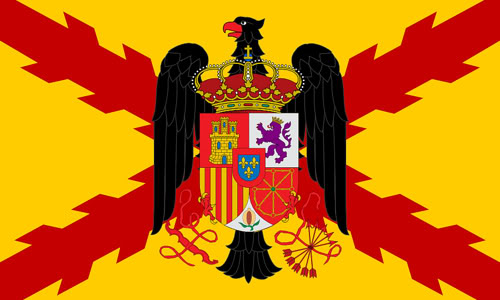With its military power and might Spain had gone on a colonial expedition along the Americas. What was the symbol on the flag that represented Spain during those years and what place does it hold today? Read on to find out.
The concept of a national flag was quite different back in the middle ages than what it is perceived to be today. In those days it was customary to have variants of the national flag. The royalty often had its own version whereas the military flag and the civil flag were different in their own rights. To some extent the idea is still practiced in some regions in the world. Spain’s historical Cross of the Burgundy flag can still be seen alongside the national flag on badges and shoulder patches. This is because the Cross of Burgundy holds a special place in the history of Spain, both in terms of the evolution of the state and the evolution of the flag.
The beginning of a legacy
The cross of Burgundy was the first real symbol that was adopted to represent Spain in the 15th century. Although foreign to the people at that time the Cross was to become the symbol of the Spanish in the years to come. It was Philip the Handsome and his wife that got the Cross of Burgundy into notice by adopting it as the national symbol of Spain. The design of the flag features red roughly pruned knotted branches that are crossed. These are situated on top of a white background and seek to represent the crucifixion of Saint Andrew. There was a time period when the Coat of Burgundy became the secondary flag for Spain as the coat of arms one was taken as the national identity. It was brought back into action by the Carlists.
The international representation of Spain
The cross of Burgundy also appeared as the symbol of Spain on the international plain. Not only was it used as the symbol of Spain during wars and expeditions it was also the symbol of the country during its years of colonization of the Americas. The flag carried by the cavalry during the Peninsula War and the South American wars of independence consisted of the Cross of Burgundy along with the royal crest. The flag featured four coats of arms which were later joined into a single flag with the unification of Coronela and Batallona.
The colonial period for Spain also saw the use of the Cross of Burgundy as it was taken as the flag of the viceroyalties of the new world. The nations that had once become part of the Spanish Empire due to the colonization expeditions of Spain now consider the Cross of Burgundy flag to be part of their historical heritage. The flag is often displayed in museums in these states as it enlivens the memories of the Spanish colonial rule. The flag of Burgundy is also raised up high daily upon the historic forts built at the National monument of St. Augustine, San Juan National historic site in Puerto Rico and Castillo de San Marcos by the Spanish to defend themselves against the new world territories. Today the colonial flag serves as a reminder to the people about the great influence and power that the Spanish empire and its military had on the world for a time period of about 400 years.





